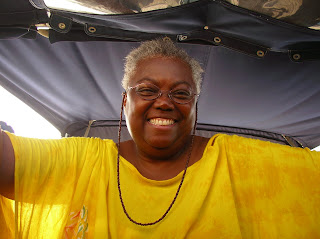Scott had done his certification in Carriacou last fall but when I checked one of the medical questions on the initial form "yes", they couldn't include me in the course without a signed letter from my doctor. I do take blood pressure medecine but it is under control. I saw my doctor when I returned to the States for the holidays and he encouraged me to dive. This spring I signed up for the course in Bonaire with my son Sean and his friend Sarah (here shown in the back of the pickup we rented for a few days).

The course takes on the average five days, although all of us completed it in four days, and our instructor said some people take much longer. It's an intensive four days. Before we arrived they suggested we complete the first three or four chapters in the book. We started two days in advance and I wish I'd begun earlier. There is a lot of material, self correcting quizzes throughout the chapters and a test at the end of each that our instructor corrected in class.

We took the course at the Carib Inn with Ralf Klug, a Dutch man who moved to Bonaire a number of years ago and is now a resident. He had a good sense of humour and carefully watched out for our welfare. Numerous drills and practices are necessary to really learn to safely dive and to instinctually handle any emergency. He watched us for signs of panic and happily didn't see any. The course alternates classroom sessions where we read, watched video instruction and discussed the material, with practical sessions in the water. The first day we used the fresh water pool, the second day the ocean off the beach and the last two days we dove at different locations off the boat, two dives a day. This picture shows me in my full diving regalia almost ready to fall backwards off the boat into the water.

Self corrected tests check for understanding throughout the course. A more comprehensive quiz follows each of the five chapters and is corrected in class. If anyone gets a question wrong Ralf went over the material until it was understood. Near the end of the program we took a final exam with 50 questions, a 75% score is necessary to pass. We all did very well on this and I believe that it would be impossible not to pass if you went through this process.
We started at 8:15AM in the morning, had a one and one half hour lunch break, and ended around 4:30PM. If you don't do all the chapters ahead of time, there's home work at night. I strongly recommend finishing the book before you begin - you're really tired after the long day. Diving is really different from snorkeling. We felt less like voyeurs and more like one of the fish. The hardest thing for me was managing my buoyency. At first I often felt I either was sinking, or more often, heading for the surface. Once my weights were adjusted correctly and I relaxed, it was effortless. There is so much to see the time goes by too quickly. Most of our dives lasted between 45 and 55 minutes. The deepest we went was 60 feet and we hardly noticed we had descended that far (although of course we were checking our depth meters and watches as instructed).


The week following our course Scott completed the PADI Advanced Open Water Certification. He did four Adventure dives and completed the course work - all still at the Carib Inn. His four dives were a night dive, deep dive, peak performance buoyancy and a navigation dive. He really enjoyed all of these, especially the night dive.
Several weeks later Scott's brother Brent took the "Resort PADI course", a one day introduction to diving. He had Ralf as an Instructor as well (picture shows Ralf on the left and Brent) and had a wonderful experience. He had a brief classroom introduction, a short time in the pool and then a shallow dive in the morning off the Carib Inn. That afternoon he did a dive from the boat off Klein Bonaire. Two days later he did another dive with Scott and myself. Because he is still not certified in any way, he had to dive with the same outfit and stay with the dive master at all times. He took this colorful shot of the corals with his underwater camera. PS UPDATE - over the next month and a half Scott and I did a lot of diving. Scott did several more night dives and I joined him for one. My record depth now is 96 feet and we went on a specially planned dive to the salt piers together. This was like an underwater cathedral. The pillars were covered with colorful corals and branches of plants. the light shining through the rows of columns was magical.




















